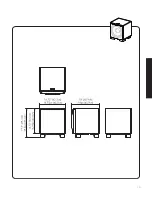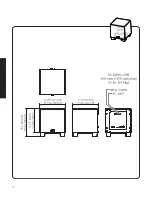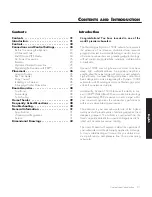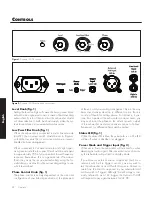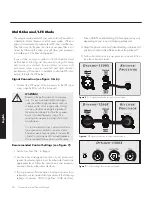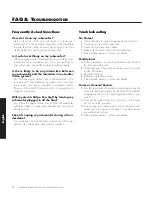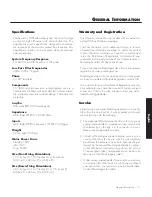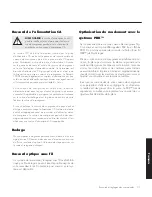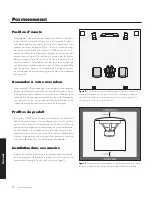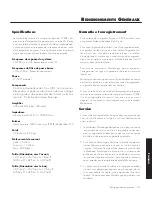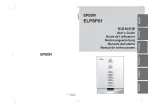
28 Room Acoustics
r
oom
a
CoustICs
This is an area that requires both a little background to
understand and some time and experimentation to attain
the best performance from your system. Your room is actu-
ally a component and an important part of your system.
This component is a large variable and can dramatically
add to or subtract from a great sonic experience.
All sound is composed of waves. Each frequency has its
own wave size, with the lower, or bass frequencies literal-
ly encompassing from 10 feet to as much as 40 feet. Your
room participates in this wave experience like a swim-
ming pool with waves reflecting and becoming enhanced
depending on the size and shape of the room and the
types of surfaces in the room.
Remember that your audio system can actually generate all
of the information required to recreate a sonic event in time,
space, and tonal balance. Acoustically, the role of an ideal
room would be to neither delete nor contribute to that infor-
mation. However, nearly every room does to some degree.
Terminology
Standing Waves
Sound coming from a speaker bounces around in a room
until a pattern emerges—this is called a standing wave.
Typically, this is only a problem with frequencies below
100Hz. When this happens different parts of your room
experience either an excess or a lack of bass.
Some people believe that having a room without parallel
walls will eliminate this effect. The truth is that non-parallel
walls only generate different standing wave patterns than
those that occur in rectangular rooms.
Usually, you can excite most of the standing waves in
a room by putting the subwoofer in a corner. Listening
position determines which standing waves you will expe-
rience. For instance, if you sit in a corner you will hear
most of the standing waves. This can be an overpowering
experience. Sitting next to a wall can also intensify the
levels of the standing waves that are experienced.
Resonant Surfaces and Objects
All of the surfaces and objects in your room are subject to
the frequencies generated by your system. Much like an
instrument, they will vibrate and "carry on" in syncopation
with the music, and may contribute in a negative way to
the sound. Ringing, boominess, and even brightness can
occur simply because surfaces and objects are "singing
along" with your speakers.
Resonant Cavities
Small alcoves or closet type areas in your room can be
chambers that create their own "standing waves" and can
drum their own "one note" sounds.
Solid Footing
After living and experimenting with your subwoofer,
you may want to use ETC™ (Energy Transfer Coupler)
Spikes (see figure 12). With the use of these spikes,
the subwoofer will become more firmly planted on the
floor and, consequently, bass will tighten. It is best not
to implement the spikes, however, until you are secure in
the positioning, as the spikes can damage the floor if the
subwoofer is moved.
Spike Installation Instructions:
1 Carefully lay the subwoofer on its side to gain access
to the bottom of the feet.
2 Firmly press the spikes into the feet.
Caution:
Make sure your hands and any cabling are
clear of the spikes. Do not slide the subwoofer as spikes
are sharp and can damage your floor or carpet.
Your Room
Figure 12.
To install the spikes, press them into the feet.
English
Summary of Contents for Dynamo 1500X
Page 1: ...Dynamo tm 1500X u s e r s m a n u a l m a n u e l d e l u t i l i s a t e u r...
Page 14: ...14...
Page 15: ...15...
Page 16: ...16...
Page 17: ...17...
Page 18: ...18...
Page 19: ...19...
Page 20: ...20...
Page 32: ...32 Dimensional Drawings Dimensional Drawings English...






